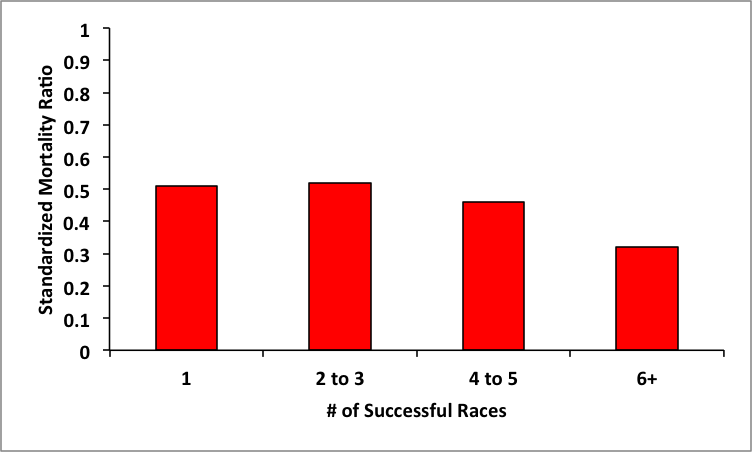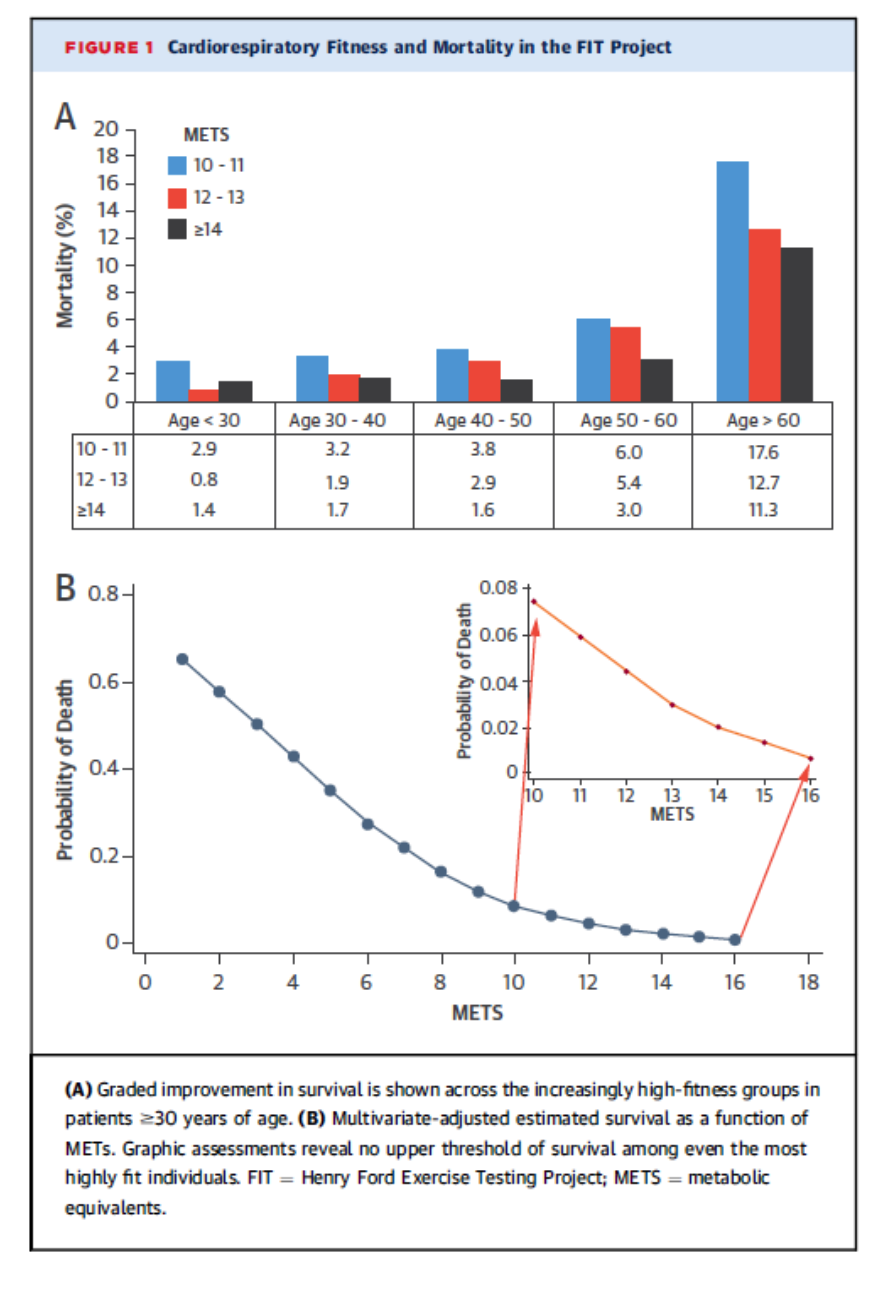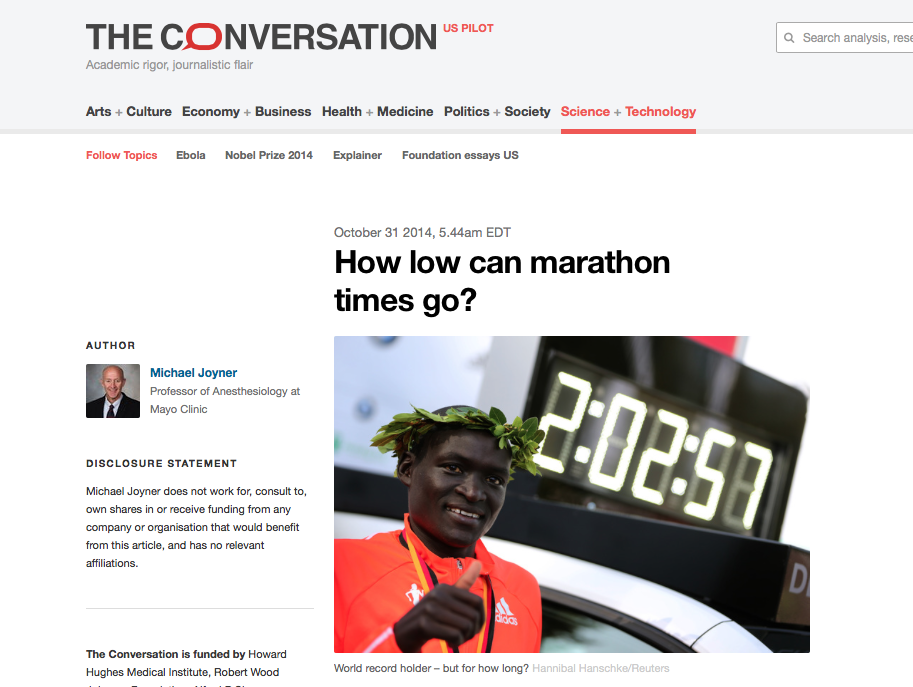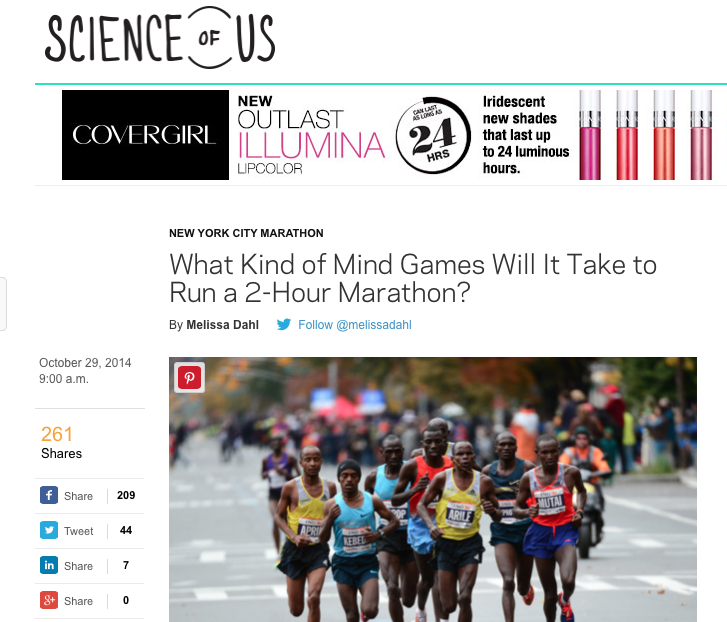Archive for the ‘Elite Sports Performance’ Category
Too Much, Too Much Exercise?
There has been yet another wave of “too much” exercise stories in the media based on a recent study of 1 million women from the UK. The idea is that moderate levels of physical activity most days with occasional bouts of strenuous activity can cause big drops in both cardiovascular and all-cause mortality. However, doing a lot of hard training is not as beneficial.
This topic has been recycling for the last couple of years. Alex Hutchinson (who has a Ph.D. in physics) has done an excellent numerical/statistical breakdown on one of the key studies that “supports” the too much exercise hypothesis. Put simply there are many limitations to the whole argument. I have done a couple of posts on what both the epidemiology and physiology tell us on the topic. The first was in 2012 and another one with Brad Stulberg in 2014. I too am a skeptic.
I am in the camp that 30-60 minutes of physical activity most days is the sweet spot for general health and that more is not better, but it is not worse either. Those who really push it most days are also likely motivated by things other than return on investment thinking about their health. Perhaps they want to compete in races or are into pushing themselves to meet more hard core physical goals.
The Swedish Skiers
Whenever this topic comes up I also bring up a paper that followed about 50,000 male finishers of the 90km (~55 miles) Vasaloppet cross country ski race in Sweden. This study used the Swedish medical records system to look at mortality in the race finishers. In preparing for an upcoming talk on exercise and health, I asked my colleague Andy Miller to generate some figures from the skiing study. The one below shows that mortality is about 50% or less than predicted for race finishers compared to the expected rate gleaned from Swedish population records. It also shows that finishing more races was not associated with an uptick in mortality, if anything it was associated with a down tick. Who knows exactly what these folks were doing, but those who finished a number of races certainly had to be doing a lot of strenuous training over many years.
Summary
I have repeatedly asked those in the “too much” much camp to rebut this paper and point out any major flaws in it. The bottom line is that it is at least as strong or stronger than the studies “supporting” the too much exercise hypothesis. Until data comes along that clearly refutes the data in the chart above I will remain a skeptic.
Fitness & Mortality Update
Two recent scientific papers make it time for a quick update on the topic of fitness and mortality.
1. Fitness vs. Cancer Mortality
The first paper is meta-analysis that summarizes the results of a number of studies on the relationship between fitness and cancer mortality. The results were pretty striking:
“Six prospective studies with an overall number of 71 654 individuals and 2002 cases of total cancer mortality were included. The median follow-up time in the studies was 16.4 years. Cardiorespiratory fitness showed a strong, graded, inverse association with total cancer mortality. Using low cardiorespiratory fitness as the reference group, intermediate and high levels of cardiorespiratory fitness were related to statistically significant decreased summary relative risks (RRs) of total cancer mortality of 0.80 [95% confidence interval (CI) 0.67-0.97] and 0.55 (95% CI 0.47-0.65), respectively. Studies that adjusted for adiposity yielded similar results to those that did not adjust for adiposity.”
This means that folks with high cardiorespiratory fitness have about half the risk of death from cancer as people in the low fit group. Usually, in these types of population studies “high fit” is defined as the ability to do “10 mets” of exercise. For example a person with a 10 met exercise capacity can typically run 6 miles (10 km) per hour for few minutes at the end of a maximum exercise test. This is also an exercise capacity that many if not most middle aged people can attain if they watch their weight and workout regularly. So while physical activity and cardiorespiratory fitness are not the same thing, many active middle aged people can get to 10 mets. The flip side of this relationship is that most highly fit people are also pretty active and they do at least some higher intensity exercise training which makes it likely they have a 10 met exercise capacity.
2. Fitness vs. Cardiovascular mortality
It has been known for a long time that increased fitness is associated with both lower all-cause mortality and lower cardiovascular mortality. A remaining question is whether this relationship flattens out at about 10 mets. In other words do people who can do more than 10 mets have even lower mortality? The graph below comes from a short report on this topic in almost 70,000 people (64% men) followed for about 12 years including about 38,000 with an exercise capacity of greater than 10 mets. The top panel shows that very high fitness was associated with lower mortality in all age groups. The bottom panel shows the dose response relationships between fitness for the entire study population. So greater fitness equals lower mortality.
Summary
Evidence for the protective effects of fitness and its close relative physical activity keeps piling up. The cancer data is especially heartening, and that fact that things don’t flatten out for fitness vs. mortality at very high levels of fitness is perhaps another piece of objective evidence against the too much exercise “hypothesis”.
Faster, Older, Younger?
It has been a while since I did a post with a hardcore “human limits” angle, but some impressive middle and long distance running results over the last couple of weeks make the time ripe for a few observations. So, here goes!
Is 45 the new 35?
In mid-February the 40 year old and seemingly ageless Bernard Lagat went 3:54.91 for the mile at the Millrose game in New York City. The previous best time for a 40+ was 3:58.15 by Eamonn Coghlan – the “Chairman of the Boards” set in 1994. Lagat went 3:51:38 at age 36 and his best mile time is 3:47:28 at age 26. Who knows just how fast he could go if he focused on the mile and ran five or ten highly competitive races in the next several years. My bet is that he could run at least a couple of seconds faster.
I also bet that if Lagat continues to train for the next five years, he might be able break 4 minutes in his middle 40s. If top competitors can avoid injury and keep training hard, it is possible for them to maintain their fitness at a level near the peak values typically seen in their 20s. However, even the most dedicated and injury free trainers start to lose something in their 40s. The minimal rate of loss for maximum oxygen uptake is probably about 4% from age 40 to 50, and this is a key determinant of mile time.
So if Lagat lost only 2% in the next 5 years that would slow his mile time by about 5 seconds and his projected age group record at 45 would be 3:58 to 3:59. The old timers reading this will remember that in the early 1970s four-time Olympian George Young broke 4 minutes in his middle 30s. At the time that seemed both inconceivable and unbelievable.
I wonder if and when we will see a sub 4 minute mile by a 50 year old?
Chasing Paula
The world record for the women’s marathon is 2:15:25, set by Paula Radcliffe who also owns the two next fastest times and no one else has broken 2:18. Her marks are true outliers and a number of people wonder if and when the field will “catch up”. On February 16, Florence Kiplagat ran the half-marathon in 1:05:09 which converts to an estimated marathon time of just less than 2:16. A few days later Genzebe Dibaba went 14:18:86 for 5,000m. That time is equal to about a 2:17 marathon.
The chart below is from an analysis that Sandra Hunter, Andy Jones, and I did on the 2-hour marathon “equivalent” for women. It shows the 100 top men and women’s times as a % of the world record with and without Radcliffe’s times. Based on these recent times at shorter distances, perhaps the men’s and women’s curves might start to look similar as more women run times between 2:15 and 2:18 in the next few years.
That having been said, it will be interesting to see if Paula Radcliffe holds the three fastest marathon times for women in five years. My bet is no.
Young Guns!
Last week Tim Kruse who worked in my lab prior to starting med-school at the University of Washington sent me an e-mail pointing out that about 20 collegiate male runners broke 4 minutes for the mile in February. In response I asked where these guys came from and he drilled down on it a bit and said that 13 came from the U.S. and several more from Canada.
The question then became why? Better training? A bigger talent pool? Better tracks? Doping? I bounced these ideas off David Epstein, Alex Hutchinson, Amby Burfoot and Rickey Carter. The general consensus was that doping was not a major issue. Better tracks and better competitive opportunities likely played a role. However, several people commented on the role internet and dedicated track and distance running sites. These sites (like LetsRun) promote the sport in general and are also a great forum to share information about training and also inspirational stories. My guess is that they have been catalytic.
Amby pointed to an article he wrote a few years ago about the “turning point” in U.S. distance running being marked by the 2000 Foot Locker High-School Cross-Country Championships which featured Alan Webb, Dathan Ritzenhein and Ryan Hall. Evidently these guys had been more or less stalking each other for some time via an early internet site devoted to high school running. Amby’s article is a great read and really nails the reasons behind improved middle and long distance running in the U.S. in specific and N. America in general.
That having been said, the depth at the collegiate level indicates the North American talent pipeline for middle and perhaps long distance running is as full as it has been in many years. It will be interesting to see if this ultimately translates into things like more international top 10 rankings, victories at major competitions and even Olympic medals.
My bet is that the East Africans might not seem so invincible in 10 years.
A Good Month
It was a good month for middle and long distance running that makes me as optimistic about the future of “my” sport as I have been for a long time. The growth of mass participation distance running by people committed to fitness has been the big story over the last 10 or 20 years. The re-emergence of a sizable number of elites in North America has the potential to be the frosting on this wonderful cake.
A Holiday Gift For Your Athlete
I get a lot of questions about exercise equipment. What is the best exercise? How to workout on the road? What “should my kid be doing to improve” etc. There is one simple answer to this question and it is also an ideal gift for almost anyone with fitness or athletic goals regardless of age who does not have too many orthopedic limitations. So what is the answer?
Get a Jump Rope and use it!
Jumping rope (or skipping rope) is outstanding for general conditioning. It can be used to generate an aerobic workout and you can things like minute on minute off intervals skipping rope. Skipping rope also develops footwork and balance. For younger athletes these are skills that carry over to almost all sports. For middle aged and older people these skills are critical to ward off things like frailty and falls. Jump ropes are also cheap, portable, and don’t require a lot of space. The video clip below shows some classic footage of boxers jumping rope. Note especially the foot work and wild routine of the great Sugar Ray Robinson. Later in the video you can see Bernard Hopkins who keeps fighting at age 50.
click for video
What kind of rope?
I have a 40 year old Everlast leather jump rope with ball bearings that my mother got me sometime in the early 1970s. This is the type of rope the boxers use and it has stood the test of time. It is also a beautiful piece of functional industrial design. But almost any rope will do.
No barriers
The specifics of skipping rope aside it is important to remember that you don’t need much if any equipment or space to develop an outstanding and effective whole body exercise routine. Skipping rope along with some simple calisthenics is free, can be done almost anywhere, and requires minimal equipment. The key requirements are simply self-discipline and motivation.
Everything You Need to Know About Endurance Training in One Race!
Last Saturday was the 50th anniversary of Bob Schul’s victory in the 5,000 meter race at the Tokyo Olympics. Schul, who was from the United States ran 13:48.8 and beat Harald Norpoth of Germany and Bill Dellinger also from the U.S. The great Kip Keino of Kenya was 5th anticipating his Olympic success in 1968 and 72, and also anticipating the rise of the Kenyan runners. It was a close race run on a slow and muddy dirt track. The last few laps of the race were very fast in spite of the conditions.
Training Methods 101
The race also serves as a short primer on training methods:
- Schul was interval trained and literally did intervals twice a day almost every day. I looked up some of his old workouts in the classic book “How They Train” by Fred Wilt. He might do a brief warmup and then 30-40 times 100 meters in the morning. The afternoon would include a brief warm up and then many longer intervals between 150-400 meters. My guess is that this sometimes added up to about 70-80 miles per week.
- Norpoth was a disciple of Ernst Van Aaken the originator of so-called long slow distance (LSD) training that included very high mileage. He did long slow runs up to 30 miles or more and also restricted his diet to get as skinny as possible. Mileage well in excess of 100 miles per week was done and perhaps only about 5% of the total was anything near race pace.
- Dellinger, who was later the track coach at Oregon, was coached by the legendary innovator Bill Bowerman and did the sort of mixed training popular today which would include longer runs, intervals, hills, and sprints. This program also featured the classic hard-easy pattern advocated by Bowerman.
- Also in the race was Ron Clarke, who ultimately set 19 distance running world records. Clarke did a lot of long fast continuous runs with surges and raced often and fast. He did what we might call threshold training. Clarke also frequently ran more than 100 miles per week in training. What he did in the 1960s also seems similar to what anecdotal reports indicate the East Africans are doing today.
Take Home Messages
The narrative above makes me an unbeliever in the idea that there is a “best way” to train or that much has really changed in the last 50 years. You can also find similar stories and varied approaches in other endurance sports with examples of success stemming from all sorts of programs.
However, all of the training programs outlined above were marked by several hours a day of training at least a couple of days a week or more. They would all also evoke essentially maximal physiological adaptations in most people. All of the programs also included at least some fast running. In talking with LSD trainers who were successful in the 1960s and early 70s, many have told me that in addition to their training they also ran a whole lot of races including “doubling” at track meets by running multiple events. This clearly supplemented the limited formal speed work they did in their regular training.
Another take home message is that depending on where you live and what resources are available one program might more sense than another. For example if you live in an urban area where finding the right course for a long run can be challenging, maybe an interval focused program on a track or in a park makes the most sense. If you live in a place full of trails, hills and mountains perhaps one of the less interval focused programs would make more sense.
Whatever the program there is no substitute for consistency and at least some fast running. Consistency also means staying injury free, so at least some easy days every week make sense as well. Also, don’t forget to ask yourself “what is the purpose of this workout?” and perhaps “what is the ultimate goal of this training program?” If you can’t answer those questions maybe you should rethink things.
New Marathon Record: An Analysis & Next Steps
On Sunday September 28, 2014 the Kenyan runner Dennis Kimetto ran the marathon in 2 hours 2 minutes and 57 seconds breaking the record of 2:03:23 set last year on the same course. Starting in 2007 with Haile Gebrselassie’s 2:04:26 the record has been broken five times, all at Berlin.
What is Physiologically “Possible”?
Back in 1991, I created a predictive model of marathon performance based on well-established physiological variables. I then asked what would happen to the marathon world record if the same athlete had optimal values for all of the key variables associated with distance running success. The predicted time I came up with for such a superman was just under 1:58:00. The model, plus some speculation, was revisited in 2011 with my colleagues Alejandro Lucia and Jonatan Ruiz and we projected that someone might break 2 hours by sometime between about 2025 and the late 2030s. So, what seemed inconceivable to many in 1991 seems to be getting closer by the year.
What Might Happen Soon?
Many elite distance runners have marathon personal bests that are about 4.6 or 4.7 times their 10k personal bests (a marathon is ~42.2k). If you use this rule of thumb then the current world record for the 10k (26:17:53) works out to a predicted marathon time somewhere between just under 2:01and about 2:03:25. Similar values emerge using various point tables and race conversion calculators. So, the current record is perhaps still a bit on the “slow” side, and I would not be surprised if the record fell by another minute or so in the next few years.
How to Make it Happen Sooner
If I were a race promoter, shoe company, or billionaire interested in wanting to get the marathon record as fast as possible as soon as possible, here are three things I would do:
- A lot of the top runners decide where they are going to run and who they are going to run against based on financial considerations. You can only run so many fast marathons per year so it is important for top runners to make each one a pay day. To get more of the top people in the same race, I would offer purses to be split by all runners under specified split times at say the half-way point, 30k, 35k, and 40k. This sort of pay out structure would encourage the top people to work together, draft, and it would not penalize risk taking if someone went out too fast and then faded. I would start with split times based on 2:02:30 and work down as records fell.
- Develop a 5 or 8k loop that was flat and had an ideal surface and then stage a yearly “elites only” race on that course. Pick a part of the world and time of the year where weather conditions are likely to be ideal with low humidity and temperature about 10C (50F).
- Run the race in the late afternoon as the sun is setting. There is some anecdotal evidence that this might be an ideal time vs. the early morning.
2:02 or Bust
When colleagues, fans and members of the media ask me what I think might happen, I tell them that something under 2:02 is possible now and that once the record gets below 2:02 the fun will begin.
You are currently browsing the archives for the Elite Sports Performance category.







